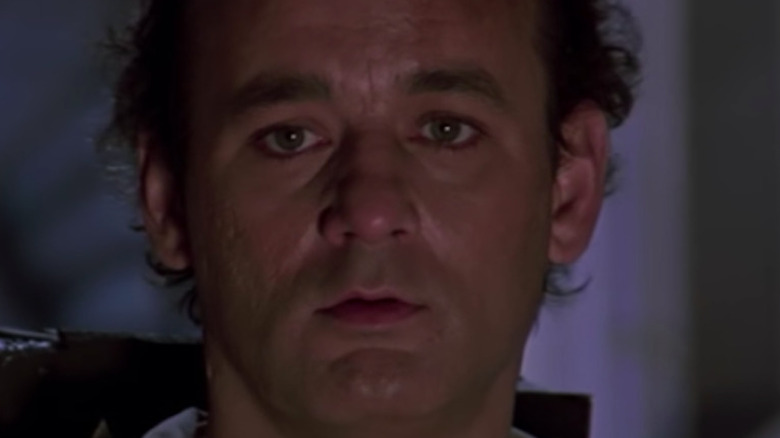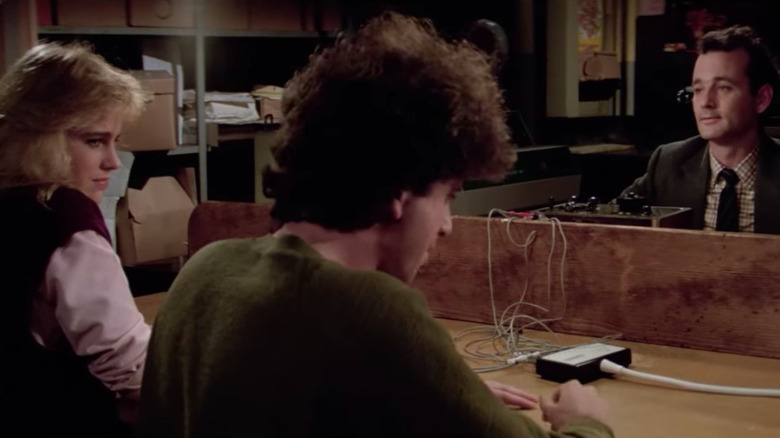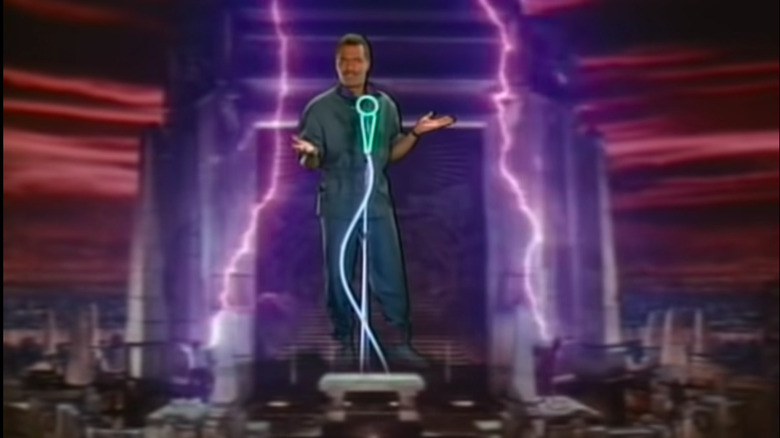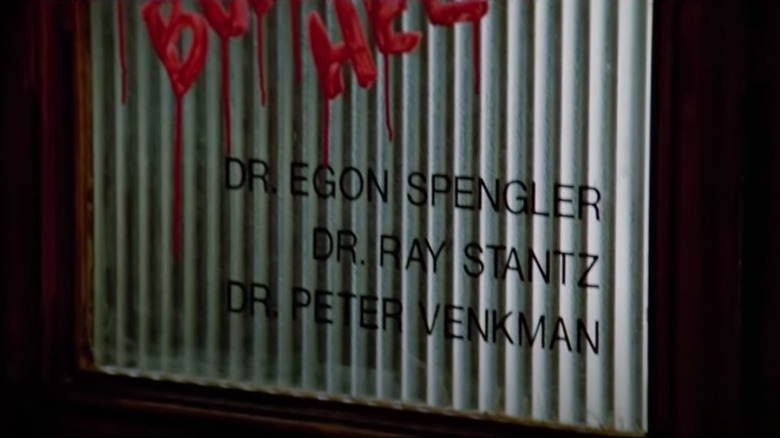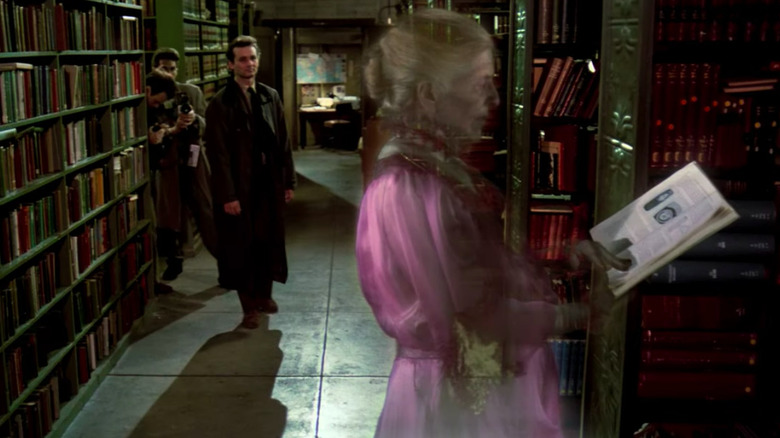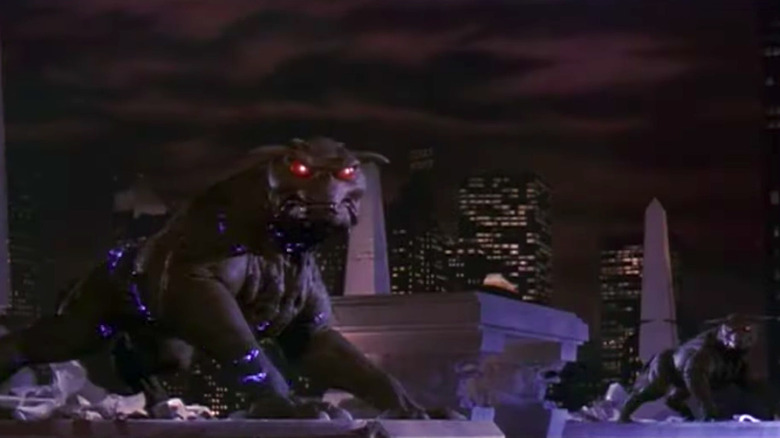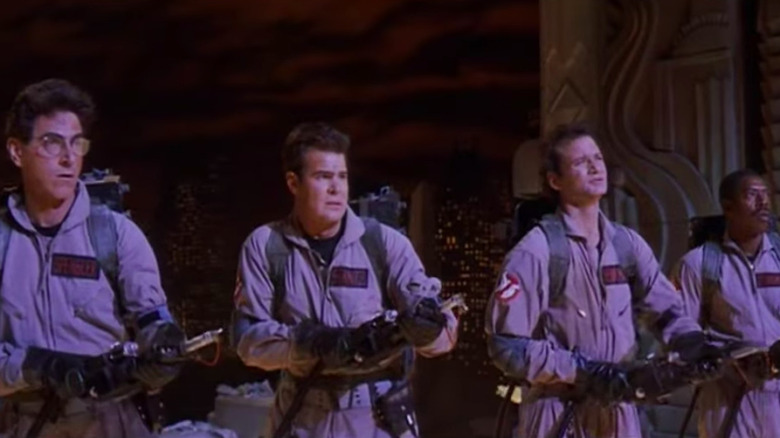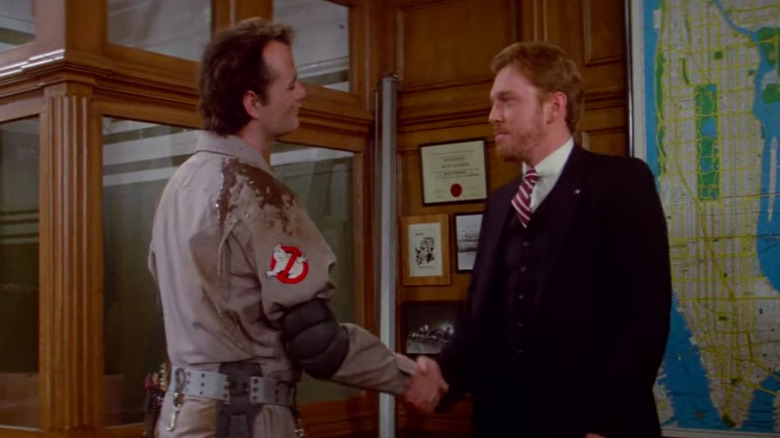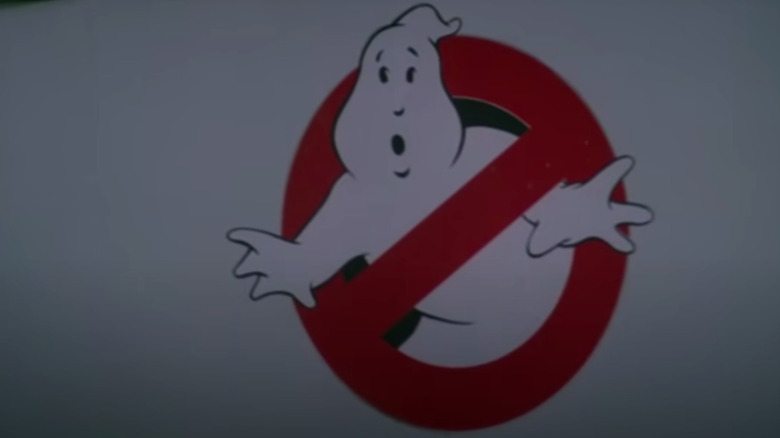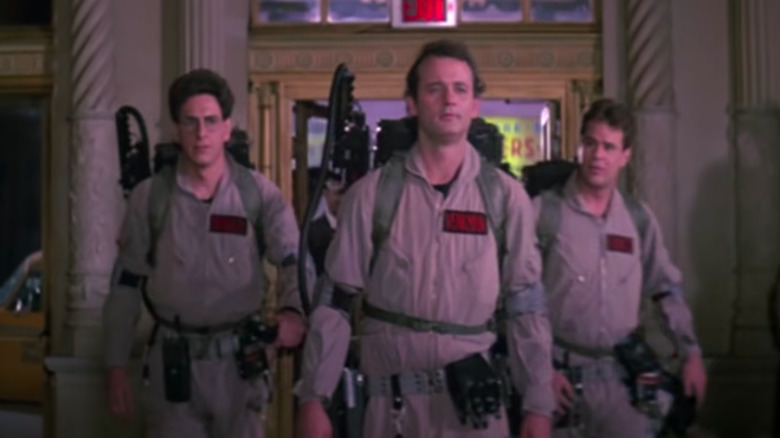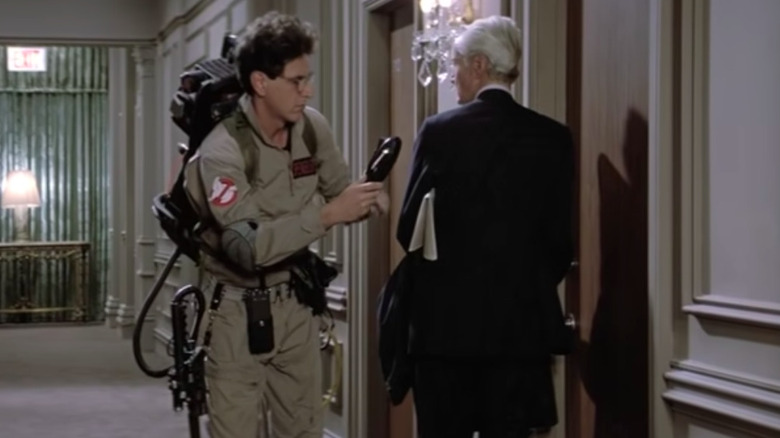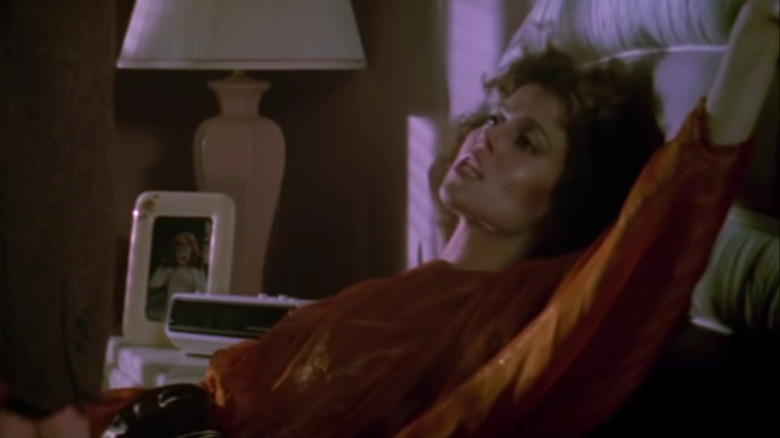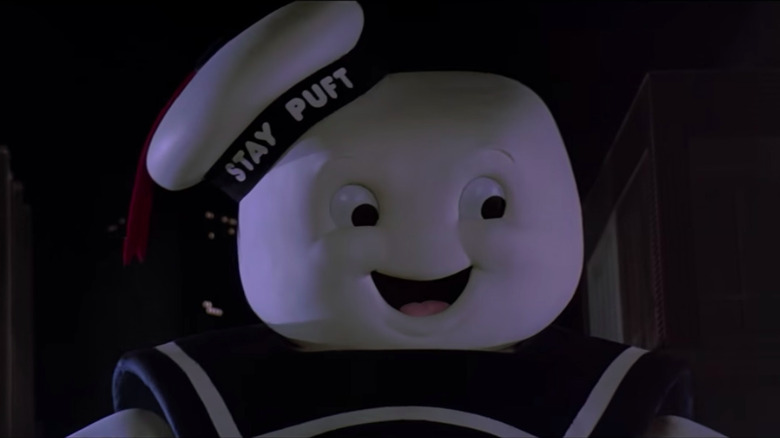6 Best And 6 Worst Things In Ghostbusters
If there's one thing we learned from 1984's "Ghostbusters," it's that busting ghosts makes us feel good. So much that pop culture's been chasing the magic of the Ivan Reitman-directed supernatural comedy ever since. Yet, even with a 1989 sequel, a 2016 reboot, and a 2021 revival, plus animated TV series and video games galore, there's nothing quite like the original.
When we meet them, Ray Stantz (Dan Aykroyd), Peter Venkman (Bill Murray), and Egon Spengler (Harold Ramis) are just three parapsychologists with a dream of keeping New York City safe by trapping and imprisoning ghosts. But it turns out, they have the right idea at the right time, as a surge of paranormal activity across the city suddenly makes the trio indispensable. With demand high and the supernatural threat growing more dire, they hire Winston Zeddemore (Ernie Hudson) to complete their team and take down the destructive god Gozer the Gozerian.
"Ghostbusters" is an irresistible combination of punchy humor and spooky scenarios, with all its eerie ghosts, strange sightings, and slimy substances offering real stakes amidst the nearly constant stream of irreverent one-liners, smirking sight gags, and hilarious set-ups. It's such a fun film that it's no surprise it's become an oft-imitated but never quite duplicated classic. However, that doesn't mean everything about "Ghostbusters" holds up. Here are the six best and six worst things about the original "Ghostbusters."
Worst: Venkman's womanizing ways
Bill Murray's Peter Venkman is an iconic movie character, but if there's one thing that's clear about him from the moment he's first seen in "Ghostbusters," it's that he's a womanizing cad. Supposedly conducting an experiment about telepathic powers with two students, he mercilessly delivers electric shocks to the man while falsely claiming the woman has correctly identified the figures hidden on the front of every card he holds up. Obviously, he's far more concerned about finding a date than uncovering the truth of the paranormal.
Venkman is even more shameless when he meets Dana (Sigourney Weaver), who comes into the Ghostbusters offices for help with the strange supernatural occurrences in her apartment. Instead of taking her concerns seriously, though, Venkman invites himself over under the guise of helping and then spends his time flirting with her. It's hard to imagine women falling for Venkman's antics in a movie today, but in 1984, they seemed to find him charming — even Dana, who initially seems like she knows better. Murray's deadpan delivery and lazy-eyed bearing make Venkman one of the funniest characters in movie history, but his approach to women no longer seems as amusing as it may have been 40 years ago.
Best: The ear-worm theme song
Just as "Ghostbusters" has endured, so has the movie's theme song. The track hit number one in 1984 and was nominated for an Oscar for best song, and it remains a beloved part of pop culture history. With its jubilant synthesizers and jingly call and response structure, Ray Parker Jr.'s ode to ghostbusting may seem a bit dated, but it's still the tune that plays in fans' heads when they think of the franchise. That's because the song, modeled after TV commercials of the '80s, was the perfect accompaniment for a film that's essentially about the creation of a small business. Plus, the infectious chorus was the source of one of the most memorable taglines in movie history, ensuring that even today, the words "Who ya gonna call?" evoke a predictable response.
Numerous artists have covered the song, but woe to those who update it for a "Ghostbusters" film, as Fall Out Boy and Missy Elliott did for the 2016 reboot, a cover as poorly received as the film. Fans may want more stories in the "Ghostbusters" universe, but what they don't want is a new version of the theme song. It's a lesson the filmmakers behind 2021's "Ghostbusters: Afterlife" took to heart, ensuring the original version of the 1984 ditty played at the end of the film. It seems that as long as there's new "Ghostbusters" content, Parker Jr. will be telling us what to do "when there's something strange in the neighborhood."
Worst: The mocking attitude toward academia
Before they start their ghostbusting business, Venkman, Ray, and Egon share an office at a prestigious university (the scenes were shot at Columbia University), where they're part of the department of parapsychology, a discipline that some regard as a pseudoscience but that several colleges and universities teach and support research on. The trio's positions indicate they all have advanced degrees, which means they've each spent years in institutions of higher education. Despite that, the movie doesn't seem to take academia particularly seriously.
Not only does the movie suggest that Venkman sees his research as a means for finding young, eligible co-eds to love and leave, it indicates that Ray and Egon, despite being serious about their work, have been pursuing investigations that haven't led to any breakthroughs — even minor ones. Nonetheless, the dean (Jordan Charney) that dismisses the group from the university is a stuck-up snob who appears to have it out for the trio, even though every point he makes — especially about Venkman being a terrible researcher — is accurate.
Sure, the movie needs the audience to root for the Ghostbusters against any adversaries, even human ones, but presenting scholarly research as a joke and characterizing the university dean as a stereotypical pompous scholar only plays into the suspicion many already have of science and academia.
Best: Some of the special effects are surprisingly convincing
Today, CGI can make just about anything a filmmaker can imagine an on-screen reality, but in 1984, visual effects weren't nearly so sophisticated, which meant the "Ghostbusters"' effects team had to be especially inventive when they brought the film's spooks to life. As if that wasn't hard enough, they only had 10 months from the time the film was greenlit to the release date to make it happen. While the effects don't have the sleek, computer-generated look we've become accustomed to, a surprising number of them still work, from the initial scenes in the library to the appearance of the ginormous Stay-Puft Marshmallow Man (more on him later).
The filmmakers employed a mixture of practical effects and animation to get the job done. For example, the first ghost the team encounters so memorably in the library was animated frame by frame — a lengthy, painstaking process. Meanwhile, the beloved Slimer, the first ghost they successfully capture, is actually a puppet controlled by a number of puppeteers. Because he had to be filmed from a fixed position, the camera was aimed at him in a way that created the illusion of movement. Even though these effects aren't nearly as polished as most of what we see today, there's something tactile and believable about them, and the meticulous ways they were filmed have ensured they hold up surprisingly well even after decades of progress in big-screen visual effects.
Worst: The demon dogs look dated
Although many of "Ghostbusters"' visual effects still work well, not all of them are equally effective. That's especially true of the demon dogs that menace Dana and her nebbishy neighbor Louis Tully (Rick Moranis). The dogs are supposed to be terrifying, but the level of fright they inspire seems to be inversely proportional to how much of them can be seen. That's because when the dogs appear in all their four-pawed glory, their movements are often distractingly jerky and unnatural.
The dogs were created through a combination of life-sized animatronics and miniature stop-motion models, and their lack of realism was especially noticeable when they were interacting with actors in their life-sized forms. When one threatens Louis and the guests at a party he's throwing, it's hard to overlook the artificial way it leaps and runs. On the other hand, the scene where just the legs of one of the dogs bursts through Dana's chair, grabs her, and drags her through a door is still one of the scariest in the film. When it comes to the demon dogs, less is definitely more.
Best: The incredible cast
The ensemble of actors that appeared in "Ghostbusters" was a veritable dream team. Headed by "Saturday Night Live" alums Dan Aykroyd and Bill Murray, the rest of the cast proved equally funny. Each has at least one stand-out moment that shows off their comedic chops, from Annie Potts triumphantly declaring "we got one" as the Ghostbusters' secretary Janine to Ernie Hudson as recently hired Ghostbuster Winston sharing his amazement about the things he's seen since joining the team with Mayor Lenny (David Margulies). Even Sigourney Weaver — whose previous roles in "Alien" and "The Year of Living Dangerously" established her as a dramatic actor — demonstrates a willingness to get silly beneath her character's dignified exterior.
Moreover, several of the actors contributed more than just their talent as performers to the movie. In fact, "Ghostbusters" was Aykroyd's brainchild, and he and Harold Ramis ultimately co-wrote the script together. Meanwhile, many of the members of the cast improvised throughout the film, including Rick Moranis, who came up with the hilarious rambling monologue he recites at the party in his apartment. Even today, after the cast has tackled numerous other projects with varying levels of success, the actors are still regarded with deep affection due to their work in "Ghostbusters."
Worst: The human bad guy is from the Environmental Protection Agency
The otherworldly destructive force Gozer may get all the attention, but anyone who's seen "Ghostbusters " knows that in many ways, Walter Peck (William Atherton), an inspector for the Environmental Protection Agency, is the story's true villain. After all, Gozer's just doing what Gozer does, while Peck's attack on the Ghostbusters is targeted, over-the-top, and ultimately endangers the whole city. Peck storms into the Ghostbusters headquarters and insists on inspecting their containment unit over concerns it's using chemicals that could hurt the environment. When he's rebuffed, he returns with law enforcement agents and shuts the unit down, launching ghostly chaos across New York, all because he wouldn't listen to reason. And even after that, at the mayor's office, he continues to argue against the Ghostbusters and their ability to contain the damage to the city, seemingly having learned nothing.
This makes Peck seem like an arrogant government bureaucrat who's willing to use the little power he has to get his way. However, the man is also just doing his job — a job that's intended to help save the environment. Given the worthy cause he represents, it's a shame the movie turns him into the bad guy. Some cultural observers have pointed out that the movie's politics are quite conservative, with themes like distrusting institutions like the government and academia and championing private business. Yet, in the process, it also dismisses the positive goals these institutions represent.
Best: The iconic logo
Along with the irresistible theme song, the "Ghostbusters" logo — designed by associate producer Michael C. Gross based on a description Dan Aykroyd wrote in the script — has transcended the film to become iconic in and of itself. Part of the appeal of the insignia, which does double duty as both the logo for the film and for the ghost extermination business the characters start, is the familiarity and simplicity of the design, not to mention the way it cleverly subverts expectations. The red "no" symbol — a circle with a diagonal slash through it — has been used to warn against all sorts of things in everyday life, from no parking to no smoking.
By placing the familiar "no" symbol on top of an adorable cartoon ghost, the logo combines something we know well with something we aren't expecting to see in our everyday symbols, ensuring the design is visually amusing and that the meaning behind it is crystal clear. Today the symbol is so widely known that it's recognized on sight for its association with the film.
Worst: The lack of diversity
While the shocking lack of diversity in the original "Ghostbusters" movie could be dismissed as a product of its time, that doesn't make it any less egregious. Outside of Ernie Hudson's Winston, there isn't a single person of color playing a major role in the movie, and even most of the small parts — from the librarian to the dean of the university to the hotel manager — are played by white people, and mostly white men.
If that weren't bad enough, even though he's held up as the fourth member of the Ghostbusters, Winston is presented as far from equal to his three teammates. Winston doesn't appear until well into the movie, and only after the ghostbusting business has become a success without him. Furthermore, unlike the other three Ghostbusters, who are all doctors of one science or another, Winston is a hired hand with no advanced scientific knowledge. While the movie doesn't put a fine point on it, the message it's conveying through its treatment of Winston and its near erasure of any other minority is depressingly obvious.
It's an issue the franchise made some strides toward correcting with "Ghostbusters II" and the cartoon "The Real Ghostbusters" — where Winston was a full-fledged member of the team — and has continued to work toward improving further with "Ghostbusters: Afterlife." Hopefully, with even more "Ghostbusters" projects slated for the near future, diversity and representation will become second nature in these supernatural stories.
Best: It's still hilariously funny
"Ghostbusters" may have hit theaters almost four decades ago, but much of the humor is still laugh out loud funny today. Sure, some of it doesn't land exactly land like it used to, but for the most part, the movie is still an amusing jaunt even amidst all the spooky frights. Much of that is the result of a group of comedic performers at the top of their game who also knew how to work with each other, leading to an easy-going back and forth between the characters that offers a steady stream of comedic banter and situations.
Plus, "Ghostbusters" includes plenty of jokes that have proven to be timeless. There are sight gags, like Egon getting so involved in searching for paranormal activity he doesn't realize he's using his equipment on a very bemused hotel guest, as well as hilarious dialogue, like Venkman telling the mayor that if he doesn't allow the team to contain the supernatural threat to the city, it'll be "Human sacrifice. Dogs and cats living together. Mass hysteria!" Plus, with all the ghosts and ghouls haunting the movie, the humor is a relief from the scary set-ups, with the absurd contrast between the jump scares and jest only making the funny moments even funnier.
Worst: The sexualization of Dana when she's possessed
When we meet Dana, she's a sophisticated woman with a buttoned-up exterior. Although she's single, she seems to have bigger concerns than finding a boyfriend even before a portal to another dimension appears in her refrigerator. However, once Zuul possesses her, Dana becomes someone else entirely, and although that someone is the servant of a demonic god, instead of becoming frightening, Dana mostly just seems to have been sexually liberated. When Zuul's in charge of her body, she wears a lot of makeup and a sparkly dress with a thigh high slit. Sure, her attire may be modest by today's standards, but for Dana, it's totally out of character. Plus, when Venkman comes over, after she asks if he's the key master, she offers her body to him without hesitation.
Ultimately, Dana's sexualization conflates sex with evil, an attitude that was also embedded in many of the slasher films of the '70s and '80s, where having sex was akin to a death sentence. Today, however, the movie's decision to have Zuul play up her desirability and emphasize her sexual yearning seems inconsistent with the malevolent forces she's supposed to represent. Moreover, while the movie plays Venkman's lust toward women for laughs, when Dana exhibits a sexual side as Zuul, her behavior is evidence of her possession. It's an unsettling double standard that hasn't stood the test of time.
Best: The Stay-Puft Marshmallow Man
"Ghostbusters" contains several memorable paranormal creatures, but the one that probably has the biggest place in our hearts is the Stay-Puft Marshmallow Man, the giant final physical form of Gozer. The charm of Stay-Puft is that even though he's huge and monstrous, he's also distinctly adorable and, when glimpsed for the first time, completely unexpected.
When Gozer prompts the Ghostbusters to choose its form before it goes into full destructive mode, it searches each character's mind for ideas. While the other three Ghostbusters ensure they don't betray their thoughts, Ray can't help but let one slip out. As he confesses he inadvertently chose Gozer's form, the suspense around what he was thinking of leads to a huge payoff when the pudgy, smiling face of Stay-Puft finally appears.
Yet, even for those who know what's coming, Stay-Puft is a delight. He's one of the best effects in the movie, even though he's really just a man in a suit walking through a miniature set of New York. Sure, we know he spells doom for the city, but he's just so cute. In addition, even after the Ghostbusters take him out, he leaves copious amounts of marshmallows lining the streets, which is a funny final touch for the film.
